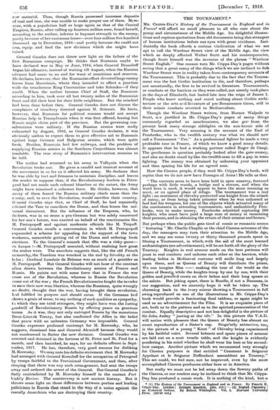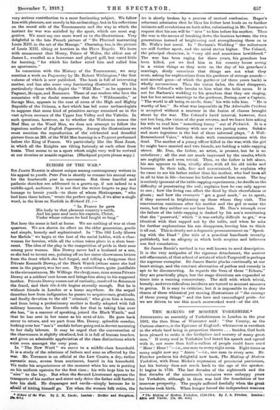THE TOURNAMENT.*
Mn. CRIPPS-DAY'S History of the Tournament in England and in France will afford no small pleasure to all who care about the pomp and circumstance of the Middle Age. Its delightful illustra- tions and copious quotations from old documents bring this strangest of human institutions before our eyes with great vividness. Inci- dentally the book affords a curious vindication of what we are apt to call the Wardour Street view of the Middle Age, the view which so deeply affected Walter Scott and his contemporaries, though Scott himself was the inventor of the phrase " Wardour Street English." One cannot turn Mr. Cripps-Day's pages without seeing that a great many of the things which we are inclined to dub Wardour Street were in reality taken from contemporary accounts of the Tournament. This is probably due to the fact that the Tourna- ment was the last Gothic institution to die, and therefore, perhaps not unnaturally, the first to be revived in literature. Tournaments, or combats at the barriers as they were called, not merely took place in the days of Elizabeth, but lasted late into the reign of James I. People who knew nothing and cared nothing about Gothic archi- tecture or the arts and literature of pre-Renaissance times, still in their mimic combats reverted to Mediaevalism.
Though the Wardour Street writers, from Horace Walpole to Scott, are justified in Mr. Cripps-Day's pages of many things commonly regarded as anachronisms, we also get- from the present book many strange sidelights on the non-heroic side of the Tournament. Very amusing is the account of the Earl of Pembroke, who in the twelfth century was what we should now call a Tournament "Pro." As a professional fighter he made a very profitable tour in France, of which we know a good many details. It appears that he had a working partner called Roger de Gaugi. The gentleman in question probably looked after the gate-money, and also no doubt stood by like the twelfth man to fill a gap in team fighting. The money was obtained by unhorsing your opponent and then sparing his life for an agreed sum.
How the Cinema people, if they read Mr. Cripps-Day's book, will repine that we do not now have Passages of Arms ! He tells us that " The contests seem to have been held in open country, featured perhaps with little woods, a bridge and a stream, and when the word lices is used, it would appear to have the same meaning as recet, or an agreed place of refuge. The tournament was a real fight ; no sentiment of chivalry protected one knight from the attack of many, or from being taken prisoner when he was unhorsed or had lost his weapons, for one of the objects which actuated many of the combatants in attending tournaments, and undoubtedly Pem- broke, was to make money. Pembroke admitted capturing 500 knights, who must have paid a large sum of money in ransoming their persons, and in obtaining the return of their armour and horses."
But perhaps when the public gets tired of comic or romantic scenes " featuring " Mr. Charlie Chaplin or the chief Cinema actresses of the day, the managers may turn their attention to the Middle Age, and we may see some twenty or thirty thousand pounds spent in filming a Tournament, in which, with the aid of the most learned archaeologists (see advertisement), will be set forth all the glory of the Tourney. Knights in real armour made on the best patterns will joust in real combats and unhorse each other at the barriers, while leading ladies in Mediaeval costume will smile long and largely upon them, and as Queens of Beauty will distribute the prizes, We can imagine Miss — making the tour of the world as the Queen of Beauty, while the knights troop by one by one, with their golden and jewelled crests on their helms and their long spears at the salute. But joking apart, there is Boodle, if not a Bonanza, in our suggestion, and we sincerely hope it will be taken up. The charming back to the ivory mirror *showing a Tournament in full swing reproduced as one of . the illustrations in Mr. Cripps-Day's book would provide a fascinating final tableau, or again might be used as an advertisement for the Film. It is an exquisite piece of art, both as to the pattern and as to the spirited presentation of the combat. Equally descriptive and not less delightful is the picture of Sir John Astley " justing at the tilt." In this picture the V.A.D. will notice with pleasure that the Queen of Beauty has almost an exact reproduction of a Sister's cap. Singularly attractive, too, is the picture of a young " Knut " of Chivalry being caparisoned by his faithful valet. Several helmets and spare pieces of armour are laid out on a neat trestle table, and the knight is evidently pondering in his mind whether he shall wear his best or his second- best casque. Another picture which we recommend very strongly for Cinema purposes is that entitled " Comment le Seigneur Appelant et is Seigneur Deffendant assemblent au Tourney." This set could, we feel sure, not be improved, even by the most
accomplished Cinema producers either here or in America. .
But really we must not be led away down the flowery paths of the Cinema, or our readers may be inclined to think that Mr. Grippe. Day has produced a comic work. It is nothing of the kind, but. a
• (1) The Riotorg of the Tournament in England and in Prance. By Francis H. Crime-Day, London ; Bernard Quaritch. tcse, net.]—(2) Brigloti Pageantry : an Historical outline. By B.obcrt Withington. Vol. 1. Burl ard University
Press. L $3•50 net.] very serious contribution to a most fascinating subject. We follow him with pleasure, not merely in his archaeology, but in his reflections on the moral side of the Tournaments and the way in which the instinct for war was satisfied by the sport, which are most sug- gestive. We must say one more word as to the illustrations. Very delightful is the late French picture of " De Pluvinel instructing Louis X.L.1.1. in the art of the Manage." Charming, too, is the picture of Louis KUL tilting at barriers in the Male Royale. We learn with amusement that Henry, Prince of Wales, the eldest son of James I., excelled as a horseman and played golf, but cared little for hunting, " for which his father rated him and called him no sportsman."
In connexion with the History of the Tournament, we may mention a work on Pageantry by Mr. Robert Withingten,2 the first volume of which is now published. The book is full of interesting matter, and has also some very fascinating illustrations. We like particularly those which depict the " Wild Man " as he appears in Pageant, Masque, and Romance. Those of our readers who love the mountains will no doubt remember that the " Wildmannlie," or Savage Man, appears in the coat of arms of the High and Mighty Republic of the Grisons, a fact which has led some archaeologists to suppose that some kind of primitive savage remained on in the vast sylvan recesses of the Upper Inn Valley and the Valtelin. In such questions, however, as to whether the Wodeman means the Mad Man or the Wood Man, we dare not attempt to follow the ingenious author of English Pageantry. Among the illustrations we must mention the reproduction of the celebrated and dreadful picture from an MS. of the Wild Men burning in a Pageant performed before the King of France. We particularly like the Boat Joust, in which all the Knights are tilting furiously at each other from boats. That seems to us a sport which might very well be revived at our riverine or seaside regattas. (Blackpool papers please copy.)











































 Previous page
Previous page